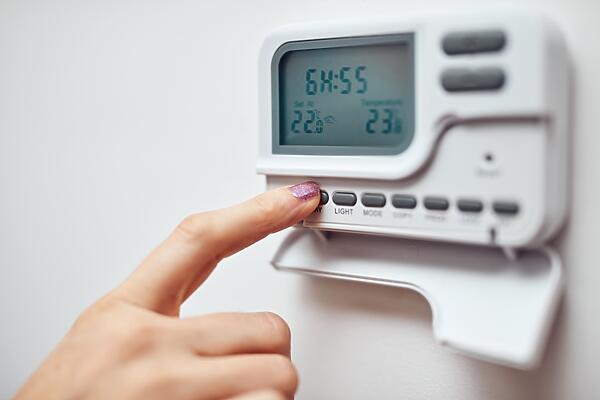7 February 2024 Cariad Marketing

An effective heating schedule is your secret weapon in the cold winter months. It not only boosts your comfort level but also slashes heating bills and shrinks your carbon footprint. Imagine – a warm haven without breaking the bank or harming the planet!
But how many hours a day should your heating actually be on and when is the best time to turn it on?
Choosing the right heating system and using it efficiently can significantly impact your comfort, energy bills, and environmental footprint.
The ideal temperature usually depends on personal preference, activity level, and occupants’ age. Over the winter months, adjusting your heating to a comfortable temperature between 18 and 20°C should help to keep you warm.
The World Health Organisation recommends 18–21°C for living areas and 16–18°C for bedrooms. And 18°C is the minimum temperature any room should be to ensure good health (based on a healthy adult wearing warm clothing). Temperatures should always be adjusted to accommodate an individual’s health conditions.
Unfortunately, there’s no one-size-fits-all answer to how many hours a day you should use your heating system. Most people keep their heating on for a little over five hours on a winter day with an average temperature of 19°C. But it really depends on various factors, such as weather conditions, insulation, and personal preference.
Well-insulated homes may only need heating for 6-8 hours even in winter, as they retain heat better. Poorly insulated homes might require 10-12 hours or more of heating to maintain comfortable temperatures.
Some people prefer warmer temperatures (19–21 °C), requiring longer heating periods, while others are comfortable with cooler settings (16–18 °C), reducing heating needs. If you stay at home or work from home, you will likely need the heating to be on and therefore use more energy than someone who goes out to work every day.
It’s okay to adjust your heating based on your daily needs and comfort level. The key is to be mindful of the factors mentioned above and avoid unnecessary heating to save energy and costs.
There’s no single “best” time to turn on your heating in the UK, as it depends on several factors influencing comfort and energy efficiency. However, many recommend the heating be switched on when outdoor temperatures reach 15°C or lower.
You should set the central heating programme to come on around half an hour before you get up and go off around half an hour before you go to bed. And if the house is empty during the day or you can manage without heating during the day, make sure you’ve set the programmer to go off for this period too.
If you have Economy 7, the cheapest time of day to use electrical devices is during off-peak hours when your local energy rates are lower, overnight, and during the early hours of the morning. This is where electric storage heaters can save you money. They are designed to store heat during the night and slowly release it into the room during the day. However, even off-peak electricity is more expensive than gas, and even the most efficient storage heaters produce less heat in the evening when you need it most.
It’s essential to create a heating schedule that keeps you warm and comfortable while keeping heating costs low and being mindful of the environment. And that starts with choosing the right heating system for your space.
Trench heating offers long-term savings due to its energy efficiency, long lifespan, space savings, and reduced maintenance. If you’re considering the best heating solution for your home or workspace, contact The Trench Grille Centre.
The number of hours depends on factors like insulation, weather, and personal comfort. Generally, 7-9 hours a day are typical during the colder months.
A good schedule balances comfort and efficiency. Consider programming your heating to turn on before waking up, decrease when away, and increase before returning home.
No, it’s generally more cost-effective to use a timer or thermostat to heat your home only when needed. Keeping the heating on low all day can waste energy and money.
The most efficient time is when you need it most, such as in the morning before waking up and in the evening when returning home. Adjust based on your schedule and weather patterns.
A comfortable temperature for most UK homes is around 18–21 °C (64–70 °F). Adjust according to personal preference and health needs.
Possible reasons include poor insulation, draughts, heating system issues, or incorrect thermostat settings.
Typically, the heating season starts around late September or early October as temperatures drop. However, it varies based on personal preference and local weather conditions.
Below 16°C (61 °F), it is considered too cold for comfort and can lead to health issues. Ensure your home stays adequately heated during the colder months.
Constantly turning the heat on and off can lead to short-term spikes in energy usage, but overall, it’s more efficient than leaving it on at a high level. Use a timer or programmable thermostat for optimal efficiency.
At The Trench Grille Centre, we have a wide range of high-quality grilles that have been carefully designed to add a sense of warmth and style to your space..
Our Linear Stainless Steel grille adds a touch of modern elegance, while the Linear Snap Profile in natural aluminium combines contemporary style with durability. For a timeless, classic look, explore our Natural Wood Roll-Up options in Ash, Beech, Oak, and Sapeli.
If you prefer a sleek and clean finish, our Roll-up Closed Profile grilles in natural aluminium and satin stainless steel are perfect choices. For a touch of opulence, consider our Roll-up Double T-Bar options in black, gold, natural aluminium, and satin stainless steel.
Elevate your space’s ambiance and comfort with our trench heating grilles, each meticulously designed to provide not only exceptional heating performance but also a touch of sophistication. Upgrade your interiors with The Trench Grille Centre and experience warmth and style like never before.
Shop Now